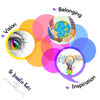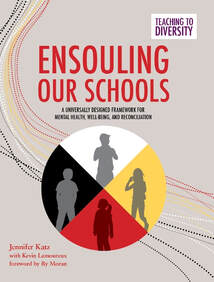The Connection:
Indigenous Education &
The Three-Block Model of UDL
True inclusion means you feel a part of the life of the class/school. Students and parents of Indigenous youth must recognize their culture, values, and ways of being within the school ethos- that is, feel at home in the school.
Mino-Pimatasiwin - "A Good Life"
As I learned from elder Bob Cardinal, most First Nations cultures believe that children are a gift from the creator. The job of a parent, and the community, is to treasure that gift, and nurture the affinities and talents of that child on all four levels of the sacred circle (medicine wheel) - spiritually, physically, mentally, and emotionally. So the question is: How do we help children, ALL children, have a good life? What does “a good life” mean? What does it mean, in narrower terms, in school?
For many parents, the western school system is antithetical to this belief. They believe the child will naturally follow the path they were meant to. It is the job of the adults to help that child discover their gift, and develop it. It is the job of the child to develop their gift, and then contribute it back to the community. But we ask parents to force their children to do things the child does not want to do (e.g. homework). We write IEP's that focus on what the child can't do, and ignore what they can and want to do. This makes "the system" seem backward, and then we pass judgement when parents "don't support the program."
For many parents, the western school system is antithetical to this belief. They believe the child will naturally follow the path they were meant to. It is the job of the adults to help that child discover their gift, and develop it. It is the job of the child to develop their gift, and then contribute it back to the community. But we ask parents to force their children to do things the child does not want to do (e.g. homework). We write IEP's that focus on what the child can't do, and ignore what they can and want to do. This makes "the system" seem backward, and then we pass judgement when parents "don't support the program."
The Four Spirits & Ensouling Our Schools
The Three-Block Model of UDL & The Four Spirits
The Three-Block Model of UDL focuses on developing a balance of wellness in the mental, spiritual, physical, and emotional aspects of life.
- Block One: Social & Emotional Learning
- Core values of the Three Block Model include community, interdependence, developing eminence, finding meaning & purpose, and trauma informed care. This fits well with many Indigenous cultures and worldviews, and in fact has been further informed by Indigenous elders, scholars, educators and friends!
- The Respecting Diversity (RD) program seeks to develop a sense of pride and dignity in all students – knowing that who they are, what they have to offer the community is of value. The first four lessons empower students through reflection on and a growing awareness of their strengths and affinities, and how they can use these to become a valued member of the learning, and larger community. In the second four lessons, students develop a sense of belonging, of being included and of being cared for, of interconnectedness with something larger than ourselves. The focus becomes on respecting diverse others, being inclusive and cooperative, and assuming leadership when needed.
- The Respecting Diversity (RD) program seeks to develop a sense of pride and dignity in all students – knowing that who they are, what they have to offer the community is of value. The first four lessons empower students through reflection on and a growing awareness of their strengths and affinities, and how they can use these to become a valued member of the learning, and larger community. In the second four lessons, students develop a sense of belonging, of being included and of being cared for, of interconnectedness with something larger than ourselves. The focus becomes on respecting diverse others, being inclusive and cooperative, and assuming leadership when needed.
- Core values of the Three Block Model include community, interdependence, developing eminence, finding meaning & purpose, and trauma informed care. This fits well with many Indigenous cultures and worldviews, and in fact has been further informed by Indigenous elders, scholars, educators and friends!
- Block Two: Inclusive Instructional Practice
- Core values include mastery oriented learning, learning communities, self-determination and regulation, truly valuing diversity (the belief that every human being is here for a reason, in our classroom for a reason, and has something to offer the community) Inclusion is not charity or tolerance (being tolerated is not being included) - it's respecting the role of diversity in survival, of our species, societies, cultures, and learning. We NEED diverse perspectives, worldviews, and learning strengths to develop intellectual and critical thinking.
- Instruction is focused on utilizing students strengths, and developing the resiliency to persevere through challenges with the support of your learning team/community, a fundamental value of most Indigenous cultures (ie that community is critical to resiliency). This differs significantly from the western value on "independence" - which expects children to be able to face a learning challenge on their own and "keep trying." For many students who struggle with verbal linguistic tasks, this expectation means that they spend five hours a day, five days a week, FOR TWELVE YEARS, doing what they can't do - and are expected to "keep trying", and behave "appropriately" (ie don't object - or we will label you oppositional)! Then we wonder why students disengage! Indigenous cultures emphasize interdependence, which in schools, means using small group/cooperative structures (called "learning teams" in the Three Block Model), to create a true learning community. The use of differentiation and the UDL principles also ensures body-kinesthetic, hands-on learning which develops skills and connects to both the physical as well as the intellectual and emotional realms, as many learners learn best this way, and become accepted members of the learning community rather than the student who "can't sit still" and "can't do the work." Thematic combinations with "big ideas" often focus on existential issues related to sustainability, and help cultivate students awareness of global issues and connections.
- Core values include mastery oriented learning, learning communities, self-determination and regulation, truly valuing diversity (the belief that every human being is here for a reason, in our classroom for a reason, and has something to offer the community) Inclusion is not charity or tolerance (being tolerated is not being included) - it's respecting the role of diversity in survival, of our species, societies, cultures, and learning. We NEED diverse perspectives, worldviews, and learning strengths to develop intellectual and critical thinking.
- Block three: Systems & Structures,
- Core values include community involvement, respect for elders, trauma informed care, equity and justice.
- Distributed leadership invites community input, and student leadership. This resembles the councils used by many Indigenous cultures. A respect for the elders of the community, and their wisdom, is critical to creating a relationship with parents and community. Collaborative, coteaching structures resemble the community collaboration seen in Indigenous cultures, and the IEP process put forward in the Three Block Model of UDL focuses on developing students strengths, and strategies for coping with challenges, rather than remediation.
- Core values include community involvement, respect for elders, trauma informed care, equity and justice.
Put together, as one Cree elder stated
"You have synthesized the wisdom of our grandmothers," (Elder Gwen Merrick).
"You have synthesized the wisdom of our grandmothers," (Elder Gwen Merrick).

